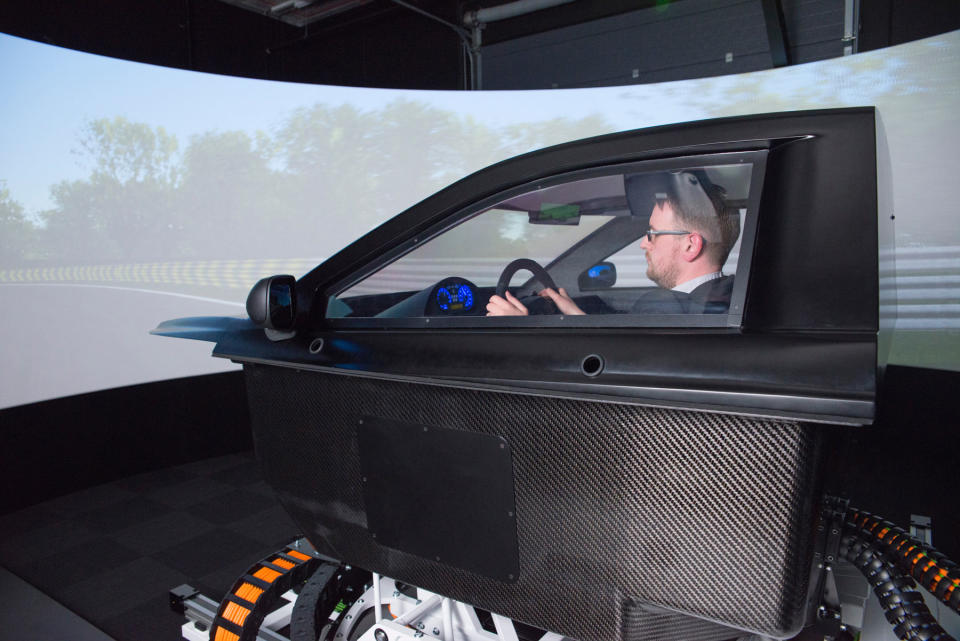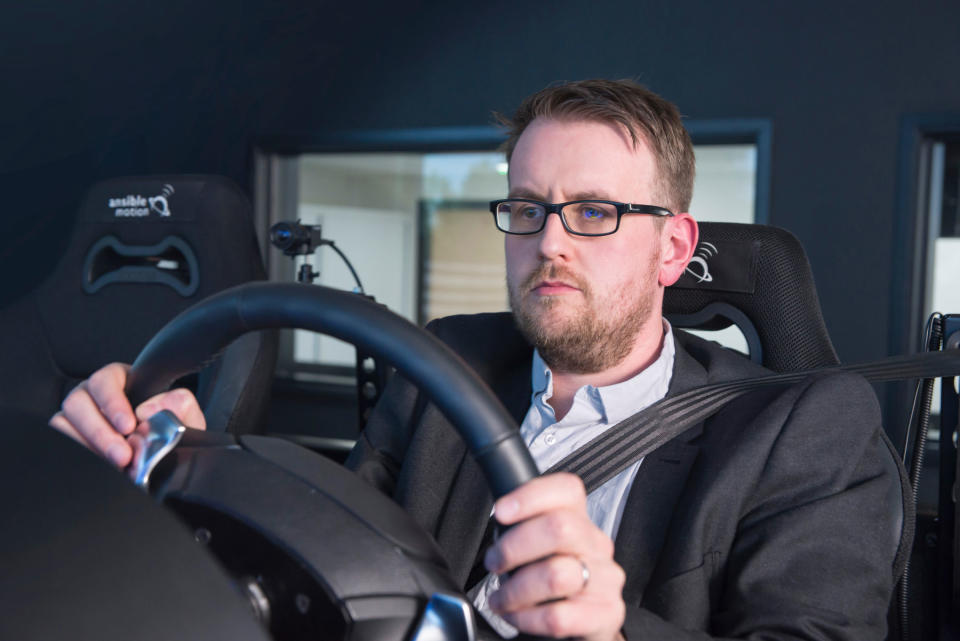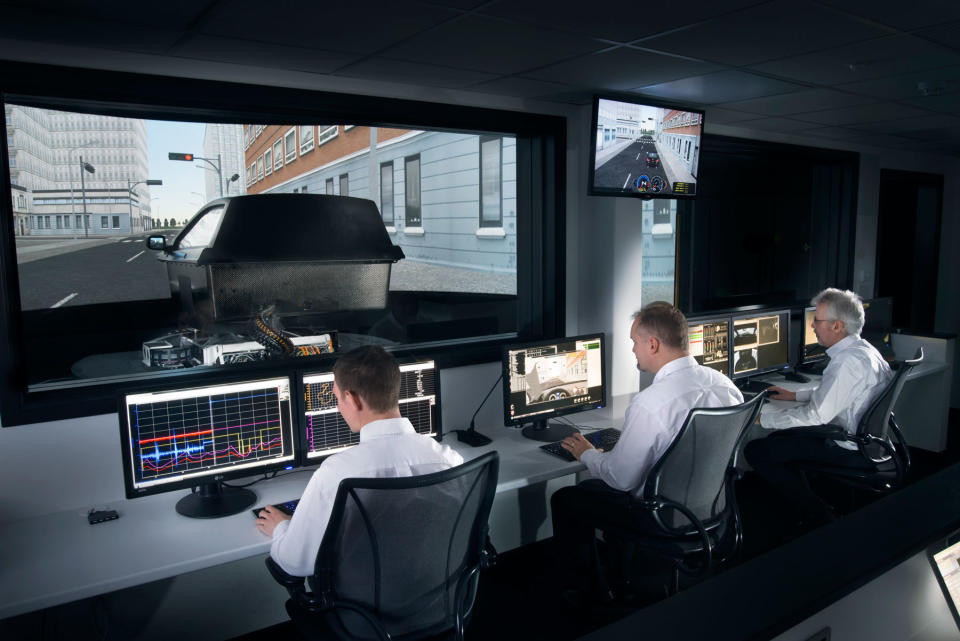Self-driving cars make me nauseous
At least, according to an experiment in a $3.8 million simulator.

One of the major benefits of our self-driving future is how much more gosh-darn productive we're all going to be. Instead of wasting brain power driving our cars to work, we'll sit back and let the ride do it for us. Suddenly, that time can be harnessed for our leisure or, more likely, to cram even more work into our days. But what will happen to all the people like me, who get sick at the thought of sitting in a car?
I'm not much of a car guy, because when I think about cars, my overriding memory is vomiting on the side of the highway. That smell of an overly warm car interior, heated by the air blowers turned up too high, makes me retch even to this day. In fact, even now, I can only avoid travel sickness by driving myself, with the air conditioning turned down low while chewing strong, mint-flavored gum.
So there's a slightly selfish motive in visiting Ansible Motion, an automotive engineering company that claims to have the world's most accurate car simulator. Most sims are built to train drivers or for fun, but this one is intended to help car designers build new cars. Engineers can sketch out a new vehicle, plug the vital statistics into Ansible's platform and test-drive it straight away.
Ansible Motion is based at the Hethel Engineering Center, a European Union-funded startup incubator on the outskirts of Norwich, England. Even for a non-petrolhead like myself, I'm aware that I'm standing on hallowed ground. If you step out of this building and walk across a neighboring field for five minutes, you'll stumble across the anonymous-looking headquarters of Lotus Cars.

The $3.8 million simulator is no substitute for real-world testing, but it can help designers avoid costly mistakes. Engineers traditionally had to wait until a prototype was built before knowing if they'd spent years creating a design that was flawed. Ansible's simulator is apparently so accurate that mistakes can be spotted and fixed before a single piece of metal is welded.
A fortunate side effect of Ansible Motion's unprecedented fidelity is that it can also be used to examine car sickness. In the near future, it'll be the test-bed for an extensive research project on mitigating the issue at an as-yet-unnamed British university. But before those experiments began, I got to see if this simulator really was good enough to induce sickness.
The simulator itself has six axes of motion, thanks to three platforms that are essentially stacked one on top of the other. Perched on top of that is the "car," a crudely drawn cockpit that's shaped like a black wedge, a stealth fighter built by hobbyists. Inside the clamshell hatch is a pair of bucket racing seats, a steering wheel connected to a fierce-looking motor and a simple dashboard. Oh, and the whole thing is lined with the same automotive fabric that I remember from my youth.
A 240-degree screen, wrapped almost all the way around the cockpit, dominates the room. Five projectors are mounted in the ceiling above, while hidden behind the screen is the rack of five servers that run the show. Once I've clambered in and strapped myself down, I'm asked to wear a pair of AKG headphones with a boom microphone. It's here that I'll be speaking to the control room and listening to binaurally recorded sound that helps replicate the experience of driving.
Before we begin, the simulator powers up and I can suddenly feel the rumble of an idling engine below me. Then the display loads and I'm able to control a generic rear-wheel-drive vehicle around a custom-designed racing circuit. The graphics aren't much better than a older iteration of Gran Turismo, but that's not the issue really. They're realistic enough to trick your eye and no more, and it does the job pretty well.

After a few laps of competent yet slow roaming around the track that'll be familiar to any 80-year-old dad, I'm told the self-driving component will soon kick in. There's a countdown, and I let go of the steering wheel to let the simulator drive me around the track on its own. The system is quick but conservative, but it manages to go faster around the track than I'd managed.
It isn't long, however, before the stale air inside the cabin begins to get to me, and the cloth lining begins to get warm. I've planned to pull out my phone and live the dream of our self-driving future at some point. But it clearly isn't going to happen, because I'm already starting to feel nauseous.
It's ridiculous to admit it, given that I'm sitting almost perfectly still in a two-story garage in Hethel. We switch back and forth a few times, me taking the wheel in an attempt to cool down my nausea before returning control to the car. But every time I let the autonomous system take over, that all-too familiar sense of discomfort returns.
Getting sick in a simulator isn't a rare problem, however; it even has a name: Simulator Adaptation Syndrome. Companies like Ansible are leaning into the concept to create systems that will purposely trigger sickness. After all, it's only after researchers know how something is caused that they will be able to properly mitigate against it. That gives me hope that someone, somewhere, isn't too far away from developing a solution that means I won't need to buy a bucket.
Of course, one random travel-sick guy isn't going to affect our self-driving future. Or is it? You see, there may be plenty of people who don't realize that they are terrible passengers, because they always drive -- for now, at least. A 2015 study out of the University of Michigan suggests that motion sickness symptoms are going to spike when people start letting vehicles take over.

Motion sickness is, essentially, caused by a disconnect between what your body and your brain perceive. Your eyes may know that you are moving, but your vestibular system -- which governs balance -- does not. Around a third of the participants in the Michigan study said that they plan to kick back and read, text, play games or watch movies. Those are all things that will affect the vestibular balance in your brain, triggering nausea or vomiting.
The study suggests that car manufacturers do what they can to reduce the effects of motion sickness. Proposed solutions include making windshields bigger and wider, overlaying graphics only onto the front window, and not installing swiveling seats.
I wonder if there's going to be a shock when all of these people start getting sick after their first trip inside a self-driving car. We may believe, or hope, that an autonomous vehicle will magically eliminate the issues that have dogged passengers for a century. But a self-driving car is still a /car/, and unless things change, many of us are still going to get sick in it.
